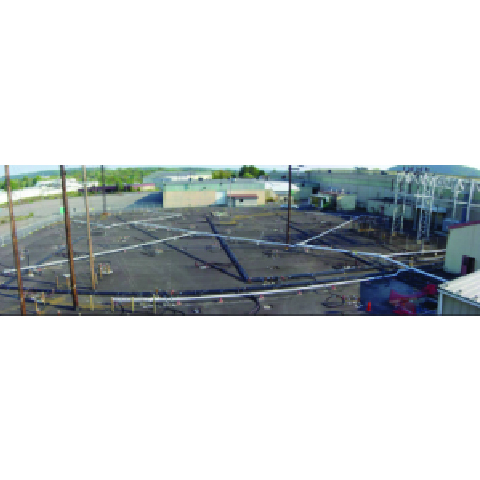Company Informaiton:Click
Site Information:
parts. A total of 26 on-site tanks and pits were reportedly used for storage of raw materials and
wastes, including gasoline, Varsol®, kerosene, fuel oil, cutting oil, hydraulic oil and waste oil.
Numerous remediation activities have been completed on the site since 1972. A brief summary of these activities is provided below.
- 1972 – Removed/abandoned Former Pits 17 and 18.
• 1986 – Leak tested and removed underground storage tanks (USTs). Closed Pits 10 and 11.
• 1987 – Installed groundwater monitoring wells and initiated routine groundwater monitoring.
• 1989 – Constructed a slurry wall and asphalt cap containment system.
» Constructed and activated a groundwater extraction and treatment system.
» Constructed and activated a light non-aqueous-phase liquid (LNAPL) recovery system.
» Constructed and activated a soil vapor extraction (SVE) system.
• 2007 – Implemented a Steam Enhanced Extraction (SEE) interim remedial measure (IRM) in the Former Pit 17/18 Area. The IRM was designed to reduce residual CVOC source mass and LNAPL within the former Pit 17/18 area.
Contaminants of Concern (COCs): were chlorinated volatile organic
compounds (CVOCs); 1,1,1-TCA, TCE, 1,1-and cis-1,2-DCE, 1,1-DCA, VC and PCBs. A significant quantity of LNAPL was present and targeted for removal as well.
Geology/Hydrogeology: Three layer unconsolidiated aquifer system comprised of:
• A fill layer 0-15 ft (0-4.5 m) below ground surface (bgs),
• Semi Confining Intermediate Silty Clay Layer 15 – 25 ft (4.5-8 m) bgs
• Sand/gravel layer 25-50 ft (8-15 m) bgs
Shallow bedrock was encountered at 40 ft (12 m) bgs, and the water levels were influenced by the nearby Susquehanna River.
Project Goals: The remedial objectives for the site were to
1. Remove NAPL within the shallow fill and deep sand/gravel unit;
2. Remove the sorbed phase CVOC mass;
3. Eliminate CVOC mass flux to groundwater;
4. Enable shut down of the existing pump and treat system; and,
5. Expedite site closure.
Results:
Approximately 26,000,000 gallons (100,000,000 liters) of groundwater was extracted from perched groundwater table within the fill unit and regional unconsolidated aquifer within the sand/gravel unit, which equates to an average total extraction rate of 34 gallons per minute (130 liters per minute) during IRM O&M.
Approximately 19,500 lbs (8,850 kgs) of CVOCs were removed from the subsurface as a result of IRM implementation. Mass removal rates up to 160 pounds per day (73 kgs per day) were observed during the initial four months of O&M. The mass removal rate was observed to stabilize after May 2008 and decrease significantly by IRM system shutdown.
Approximately 12,700 gallons (45,000 liters) of LNAPL were extracted from the subsurface, recovered by separation, and then disposed offsite by incineration. A decreasing trend in LNAPL recovery was also observed though completion of IRM O&M.
May 2009 influent concentrations for 1,1-dichloroethane (1,1-DCA), 1,1-dichloroethene (1,1-DCE), cis-1,2-DCE, and 1,1,1-trichloroethane (1,1,1-TCA) were reduced by more than 90 percent relative to their
respective maximum sustained value. Trichloroethene (TCE) reduction was reported to be 85 percent; however, its maximum sustained is likely biased low due to elevated detection limits in November 2007.
The offgas treatment system consistently achieved greater that 99 percent destruction and removal efficiency (DRE) for VOCs, excluding two minor exceptions (both greater than 97 percent DRE)
